Thinking about turning your city rooftop into a cool garden? Start simple: pick the right pots and mix up some good soil. Use sturdy, nice-looking pots like those made from cedar or teak. Mix some light potting soil with compost to help your plants grow strong and healthy.
Now, what about the wind that can be really strong up high, or not having enough water? And how do you make sure your plants get enough sun but still fit everything in your space?
Let's figure out how to deal with these things so you can have an awesome garden right on your rooftop!
Key Takeaways
- Pick containers made of lightweight materials like cedar or fiberglass and use light potting soil. This makes it easier to handle and keeps the roof safe.
- Set up a drip irrigation system with a timer. This helps give your plants the right amount of water without wasting any.
- To keep your plants safe from strong winds, you can use fences, build walls, or plant types that handle wind well.
- Go for local plants that are tough and can handle being on a rooftop, like sedums and succulents. These plants don't need much water and can grow strong roots.
- Use mirrors to spread out the sunlight better, so all your plants can get the light they need, even the ones in shady spots.
Container Choices for Rooftops
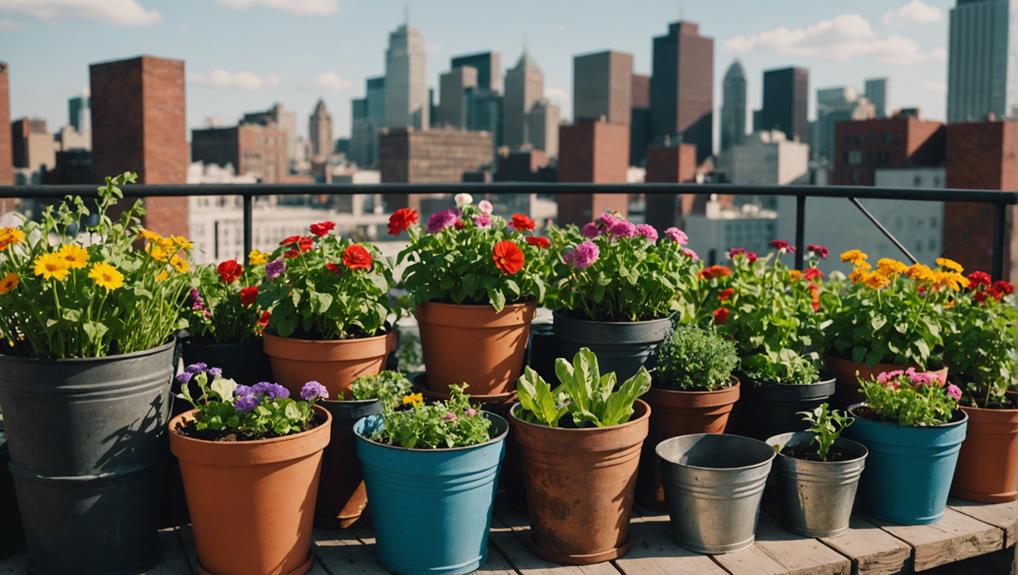
Choosing the right containers for your rooftop garden is crucial. You can pick from materials like cedar, teak, plastic, stoneware clay, or fiberglass. Each type has its own special benefits for your garden.
Cedar and teak are strong and don't get damaged easily by weather or bugs, so they last a long time. Plastic and fiberglass are super light, making them easy to move around, which is really handy when setting up a garden on a roof.
Stoneware clay containers are heavier but they look nice and don't tip over easily, which is great for windy places like rooftops. These containers also let you be creative with their designs to make your space look cool.
When you put soil in these containers, make sure it's a light type of dirt. This helps make sure your roof isn't too heavy for your garden and that your plants grow well.
Optimizing Soil Composition
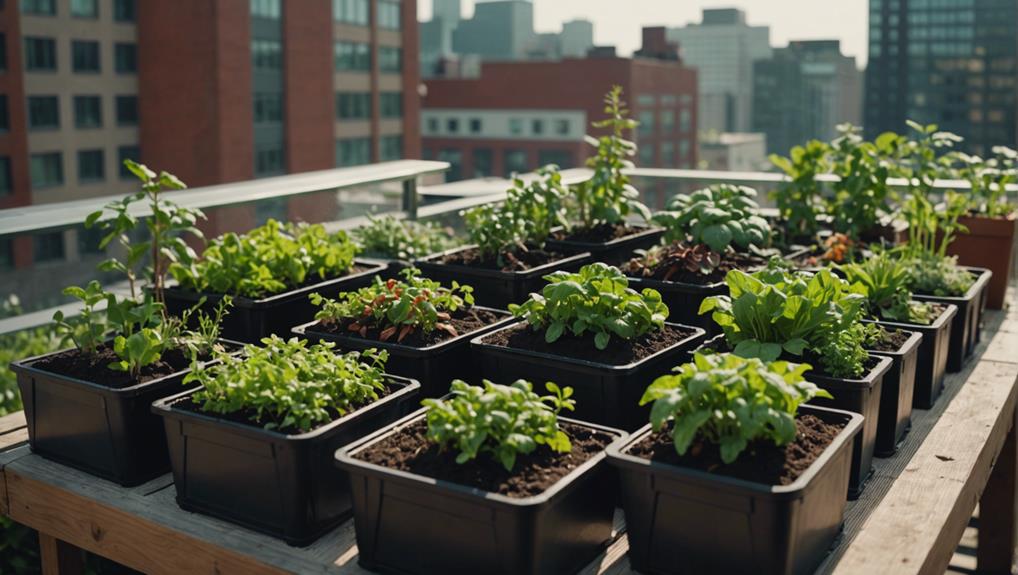
To make the best soil for your rooftop garden, start with lightweight potting soil. It's easier on your rooftop and helps plants grow better because it lets their roots breathe and water move through easily.
Adding compost when you plant helps a lot too. Compost is like a superfood for your garden. It comes from natural stuff like leaves and food scraps, so it's safe and healthy for your plants. Plus, you can make your own compost at home, which is really cool and good for the planet.
Also, think about using a drip irrigation system. This is a way to water your plants that makes sure they get just the right amount without wasting any water. It's perfect for rooftops where it's hard to water plants the usual way.
Wind Mitigation Strategies
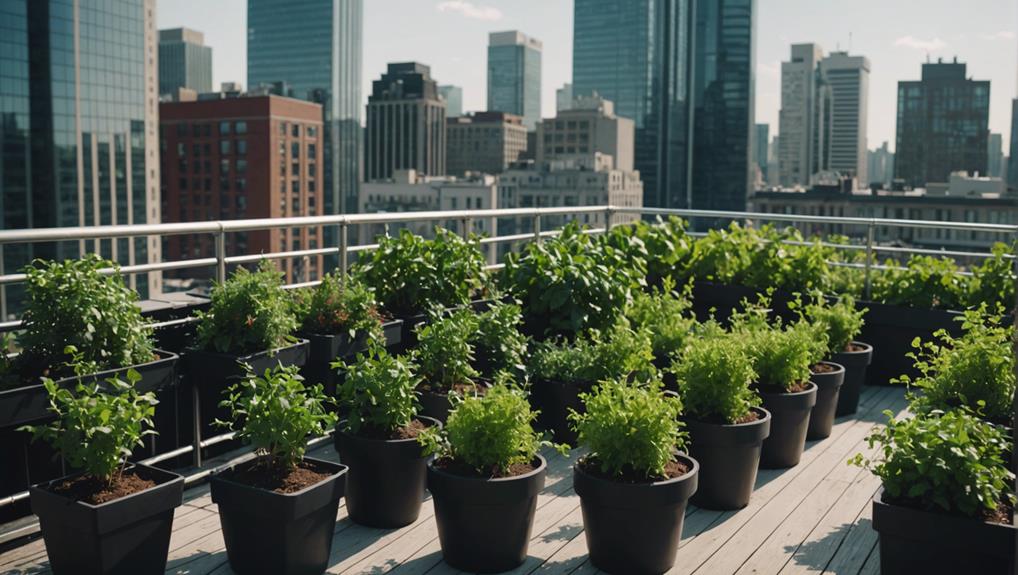
When setting up a garden on your rooftop, it's really important to think about the wind. In cities, the wind can be strong and can dry out your plants quickly, making it tough for them to grow well.
Here are some cool ways to keep your garden protected from the wind and still look nice.
First, you could put up walls or fences. These don't just block the wind; they also give you a spot to hang plants or let climbing plants grow up them. This makes your garden look even greener and keeps your plants safe. Try to pick materials that look good with your building and the rest of your garden.
Next, choose plants that are tough and can handle the wind, as well as cold and lots of sun. These plants will do better in your rooftop garden because they don't need as much water, which is great since the wind can make the soil dry really fast.
Efficient Watering Systems

Efficient watering systems, like drip irrigation, are super important for keeping your rooftop garden healthy. In cities, saving water is really important, and using a smart drip irrigation system helps a lot.
Here's how to set it up for the best results:
- Install a Drip Irrigation System: This system puts water right at the plant roots. It stops water from evaporating too much or running off where it's not needed.
- Connect to an Outdoor Water Supply: Hook your system up to an outdoor water source on your roof. This way, you don't have to carry water up and down, and your plants always get enough water.
- Use Timers: Put timers on your system to water your plants early in the morning and late in the evening. This helps stop water from evaporating too fast and makes sure your plants get all the water they need.
- Get Kids Involved: Let kids help with watering the plants. It's fun for them and they learn how to take care of the environment.
Composting on Rooftops
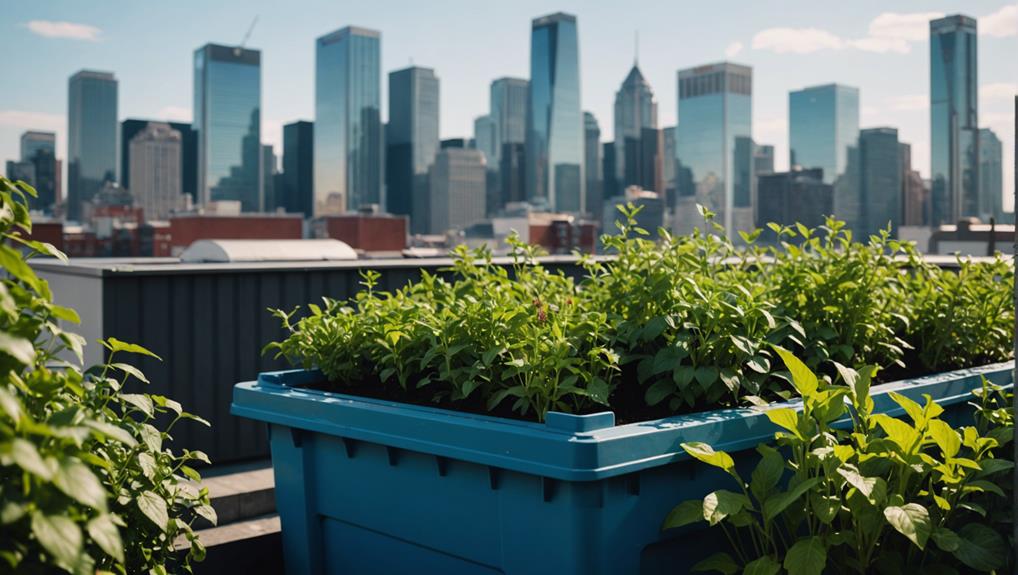
Turning kitchen leftovers into compost on rooftops is a cool way to help your garden grow. When you compost, you're not just throwing less trash away, you're making your environment better.
Starting with a small compost pile using scraps like banana peels and apple cores is easy. This turns into super soil that makes your rooftop plants happy and healthy.
Composting up high fits right in with city living. It saves space and helps your garden without needing extra land. By composting, you keep stuff out of busy landfills and use it to boost your garden instead.
Your garden gets better at growing things, and it's a great way to keep your city spot cleaner.
Adding compost when you plant new things in your garden helps them grow strong and healthy. This way, you make your rooftop garden a cool spot in the city that shows how you can grow your own plants and help nature at the same time.
Selecting Resilient Plants

When setting up a garden on a rooftop, it's really important to pick the right plants. Rooftops can be tough places for plants because they're so exposed to the sun and wind. Here are some tips on how to choose the best plants for your rooftop garden:
- Go for Water-Savers: Some plants, like sedums and succulents, don't need much water. They're great for rooftops because they can handle the extra sunshine and heat without needing daily watering.
- Choose Strong Root Plants: Plants that grow deep roots are better at staying put and not getting knocked over by the wind. This makes them great for high places like rooftops.
- Pick Plants from Your Area: Plants that naturally grow around your city are usually easier to take care of because they're used to the weather and soil. Plus, they help the local bugs and birds.
- Look for Tough Plants: Some plants are really good at fighting off bugs and diseases on their own. Choosing these types of plants means you won't have to use as many sprays or chemicals to keep them healthy.
These tips should help you create a thriving garden on your rooftop without too much trouble!
Utilizing Vertical Spaces

If you have a garden on your rooftop, you can make it even cooler by growing plants up walls or on tall racks. This way, you use less space and still get a lot of greenery. It's like turning a small patch into a mini jungle!
By growing plants on things like trellises or in hanging pots, you make your rooftop look amazing and help clean the air. These plants take in bad stuff from the air and give out clean oxygen.
These setups don't just look pretty; they also make your building cooler in summer and warmer in winter, and they can make it quieter too. Plus, imagine your rooftop garden helping bugs and birds by providing them with a nice place to hang out.
Reflective Light Management
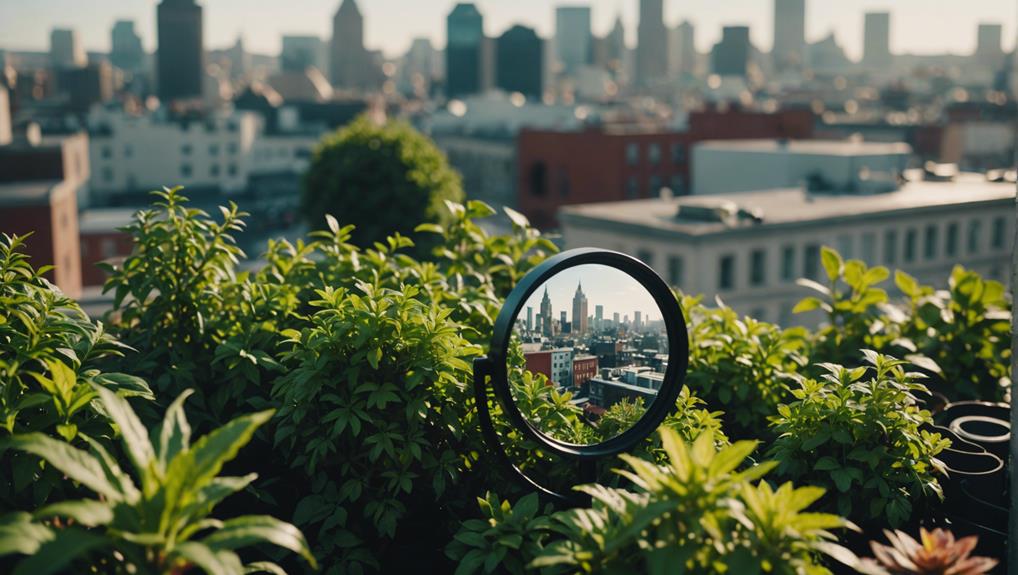
When you're setting up your rooftop garden, think about how to bounce light around. Use mirrors to spread sunlight to shadier spots.
This helps all your plants get enough sun and makes your garden look cool too.
Maximizing Sunlight Exposure
Creating a sunny spot for your plants on a city rooftop can be really cool! Here are some neat tricks to make sure your garden gets enough light and looks great, too:
- Choose Dark Paint for Walls: If you paint the walls around your garden dark colors, they won't reflect too much light. This is good because too much bright light isn't always best for plants.
- Grow Vines on Walls: Putting vines on the walls looks awesome and helps give some plants a break from too much sun while letting others get just enough.
- Place Plants Smartly: Put your taller plants in spots where they can block some of the sunlight from hitting the smaller, more delicate plants. This helps all your plants get just the right amount of light.
- Use Special Containers: Pick containers for your plants that help soak up sunlight. This makes it easier for your plants to grow strong and healthy.
These steps will help you have a thriving garden on your rooftop, even in the city!
Utilizing Mirrors Strategically
Using mirrors in your rooftop garden is a smart way to spread sunlight everywhere. This helps the plants that don't get enough light.
Instead of using extra electric lights, mirrors can bounce the sun's rays to darker spots where the sun doesn't usually shine. This way, all your plants can grow well.
Plus, mirrors can stop the sun from being too strong on some plants, which might hurt their leaves. This is a simple and cheap way to make your garden better with the sunlight you already have.
Adhering to Building Codes

To have a great rooftop garden without getting into trouble, it's really important to follow the rules about how heavy things can be, how tall structures are, and what materials you should use. Knowing these rules helps you create a cool rooftop garden that's safe and won't cause any problems.
Here are some important things to think about:
- Checking the Weight: Make sure your roof can hold the weight of the soil, plants, and pots. Spread out the weight so your roof doesn't get damaged and your garden can last a long time.
- Choosing the Right Stuff: Use materials that the rules say are okay. This could be special types of green roof setups or tough tiles that keep water out.
- Being Safe with Fire: If you want to use wooden decks, check that they're safe from fire according to the rules. You could also use treated wood or other materials that don't catch fire easily.
- Keeping Water Away: Set up good drainage so water doesn't sit on your roof and make sure there's a clear path for getting around and fixing things.
Following these tips will help your rooftop garden do well and be a cool example of gardening in the city.
Seasonal Maintenance Tips
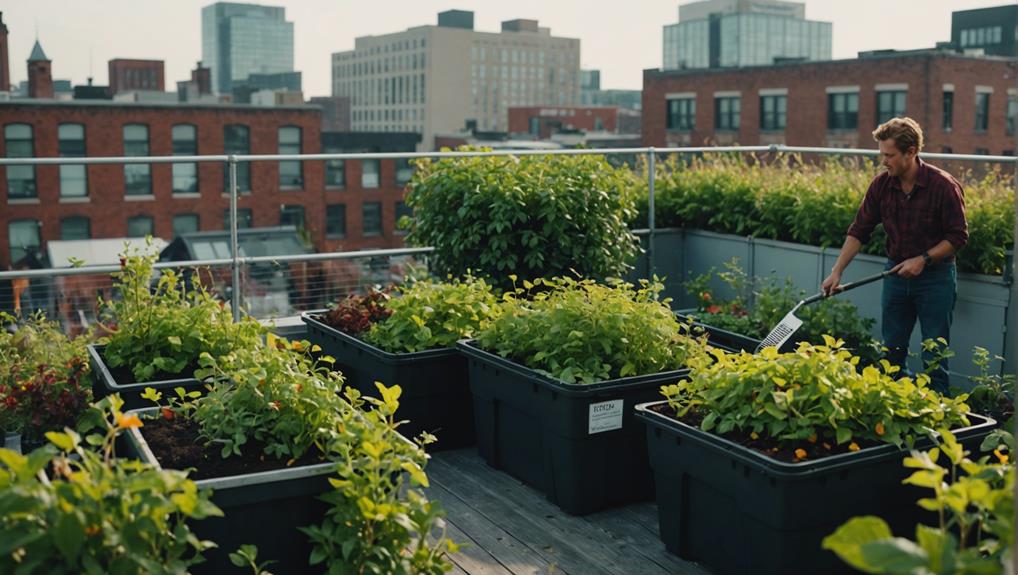
As the year goes on, it's cool to change how you take care of your garden on the roof to help your plants do their best.
When it gets cold, make sure to cover your plants and keep them warm to save them from the cold and ice.
But when it's hot, remember to water them more and shield them from too much sun so they stay healthy and happy.
Winterizing Your Garden
Getting your rooftop garden ready for winter is super important, especially because city gardens don't have the natural shields that country gardens do.
Here's a simple guide to keep your garden happy in the cold:
- Keep Tender Plants Safe: Use burlap or a special cloth to cover plants that don't like the cold. This cover keeps them warm and lets the plants breathe so they don't get too wet and sick.
- Add Mulch: Put a thick layer of stuff like straw or crushed leaves around your plants. This keeps the ground moist and warm. Plus, it makes the soil better because it adds nutrients.
- Trim and Tidy Up: Cut back plants that come back every year and take out the old ones that won't come back. This makes your garden look neat and keeps bugs and sickness away.
- Look After Containers: If you have plants in pots, wrap the pots with bubble wrap or move them to a spot that's more protected from the cold. This keeps the dirt from getting too cold and hurting the plant roots.
Summer Plant Care
Taking care of your garden during the summer, especially on a rooftop, is really important because it can get super hot up there! Here are some cool tips to help your garden stay fresh and healthy.
First, make sure to give your plants enough water every day to help them beat the heat. A smart way to do this is by setting up a drip irrigation system. This system is awesome because it saves water and gets it right to the plant's roots, which is exactly where they need it the most. You can even add a timer to help keep the watering regular without you having to remember all the time.
Then, it's a good idea to make your soil even better by mixing in some compost at the start of the summer. Compost is like a superfood for plants—it gives them all the nutrients they need and helps the soil hold onto water better. You can make your own compost by using old food scraps from your kitchen, which isn't only cool for your plants but also great for the planet because it cuts down on waste.
With these tips, your rooftop garden will be all set to look beautiful all summer long!

